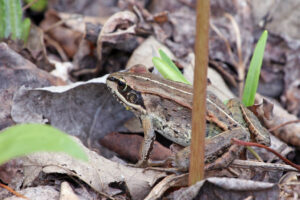
Wood frog. Wood frogs are one of many species that use vernal pools for breeding. 
Article Written by Grace Vachon
A large puddle of water in the middle of the forest might not seem like much, but if you take a minute, sit quietly, and watch; you will notice that this seemingly unremarkable puddle is teeming with life. These puddles are called vernal pools, and some vernal pools can even be classified as wetlands. However, they differ in that they do not continuously receive water from another source. Rather, they fill with water from snowmelt and rainfall in the fall or spring, hold this water for a period of time, and then dry out in late summer. This cycle of filling with water and then drying out occurs every year. Fish cannot live in vernal pools since they are only filled with water for part of the year, making them safe breeding sites for amphibians like frogs and salamanders. Amphibians will migrate from larger wetlands or upland areas to vernal pools to deposit their eggs. The young then leave the pool in summer or early autumn before it dries out. Other organisms like fairy shrimp and insect larvae also make their home in vernal pools.
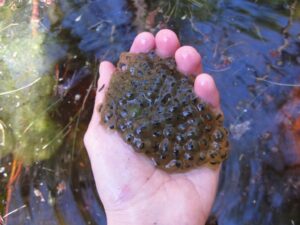
Wood frog egg mass. Wood frog egg masses tend to appear lumpy.
Two cool frog species that can be found in the Mashpee Wildlife Refuge are wood frogs and spring peepers, and both use vernal pools for breeding. Spring peepers are known for their raucous chorus of high-pitched “peeps” that can be heard throughout the spring months. Listen for this chorus to know that spring is here. Wood frogs migrate from their woodland habitats to vernal pools in the springtime, where they produce large, gelatinous masses that can contain up to a thousand tiny eggs. During the breeding season beginning in March, listen for their “quacking” call. Wood frogs have an interesting adaptation that allows them to withstand extreme cold. If they freeze, they survive by producing glucose which prevents ice crystals from penetrating their cells and killing them. As a result, they can withstand sub-zero temperatures in cold climates.
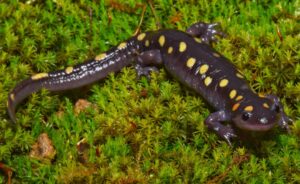
Spotted Salamander. This image is licensed under CC B.Y. 2.0.
However, frogs are not the only amphibian that produce egg masses. Salamanders like the spotted salamander also do. If you find a vernal pool this spring, look closely and see if you can spot any egg masses beneath the water’s surface. They will most likely be attached to vegetation like reeds and logs. Wood frog and spotted salamander egg masses may appear similar at first glance, but there are clues that you can use to distinguish between them. A key difference is the presence of a gelatinous coating around the outside of the mass. Spotted salamander eggs masses have this coating while wood frog egg masses do not, making wood frog egg masses appear lumpy. Also, wood frog eggs tend to be laid in large, communal rafts. Once the offspring emerge from all of these tiny eggs, they will leave the vernal pool before all the water is gone for the season.
Vernal pools are important since they serve as safe nurseries for amphibians. However, they are threatened by land development, and it can be difficult to protect them. If a vernal pool is part of a protected and recognized wetland system, it is protected. Unfortunately, small or isolated vernal pools may be overlooked and left unprotected, even if they provide important breeding habitat. But even these vernal pools can become certified as a means of protection. To certify a vernal pool, any person can submit a request to Mass Wildlife’s Natural Heritage and Endangered Species Program. Another way to protect vernal pools is also to conserve the habitats surrounding them, since the animals that migrate to them every spring use these habitats as well. All in all, vernal pools are much more than random puddles of water in the middle of the forest. Rather, they are teeming with abundant life and need protection.
Additional Resources and Images:
Learn more about vernal pools and their protection: Vernal-Pools_Fact-Sheet (Mass Audubon)
Learn how to identify egg masses- Egg Mass Identification Guide
See this video of Wilson Acuna with the U.S. Fish and Wildlife Service talking about vernal pools and egg masses. This was taken during our Walk for the Wild route walk on April 2nd. Wilson at Vernal Pool 4 2 24 (youtube.com)
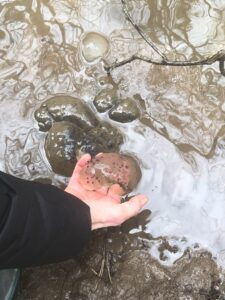
Spotted salamander egg mass. Spotted salamander egg masses are coated with a gelatinous coating unlike those of the wood frog. As a result, they appear more smooth. These egg masses were spotted on the Walk for the Wild route walk on April 2nd.
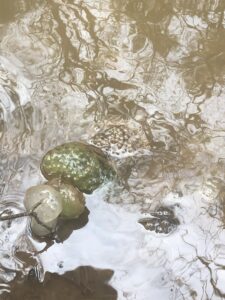
Mysterious green egg masses. These were also spotted during the Walk for the Wild route walk. We are unsure what animal these come from, but they do look very cool.
